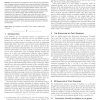Free Online Productivity Tools
i2Speak
i2Symbol
i2OCR
iTex2Img
iWeb2Print
iWeb2Shot
i2Type
iPdf2Split
iPdf2Merge
i2Bopomofo
i2Arabic
i2Style
i2Image
i2PDF
iLatex2Rtf
Sci2ools
ECCV
2004
Springer
2004
Springer
A Fourier Theory for Cast Shadows
—Cast shadows can be significant in many computer vision applications, such as lighting-insensitive recognition and surface reconstruction. Nevertheless, most algorithms neglect them, primarily because they involve nonlocal interactions in nonconvex regions, making formal analysis difficult. However, many real instances map closely to canonical configurations like a wall, a V-groove type structure, or a pitted surface. In particular, we experiment with 3D textures like moss, gravel, and a kitchen sponge, whose surfaces include canonical configurations like V-grooves. This paper takes a first step toward a formal analysis of cast shadows, showing theoretically that many configurations can be mathematically analyzed using convolutions and Fourier basis functions. Our analysis exposes the mathematical convolution structure of cast shadows and shows strong connections to recent signal-processing frameworks for reflection and illumination.
Related Content
| Added | 01 Jul 2010 |
| Updated | 01 Jul 2010 |
| Type | Conference |
| Year | 2004 |
| Where | ECCV |
| Authors | Ravi Ramamoorthi, Melissa L. Koudelka, Peter N. Belhumeur |
Comments (0)

